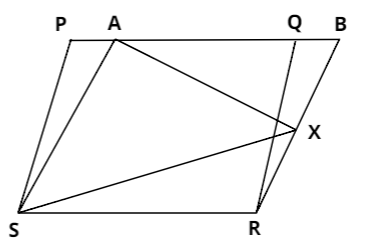
Answer
500.4k+ views
Hint: Both the parallelograms are lying on the same base and within the same parallel lines.
$(i)$Consider parallelograms $PQRS$ and $ABRS$. They are lying on the same base $RS$ and between the same parallel lines $RS$ and $PB$. And according to the property of parallelogram, we know that parallelograms lying on the same base and between the same parallel lines have equal area. Therefore:
$ \Rightarrow $ area$(PQRS)$$ = $area$(ABRS)$.
$(ii)$Now, consider $\Delta AXS$ and parallelogram $ABRS$. Both are lying on the same base $AS$ and between the same parallel lines $AS$ and $BR$. And we know that the area of the triangle having the base as a parallelogram and its third vertex lying on the opposite parallel side of the parallelogram is half the area of the same parallelogram.
$\therefore $ area$(AXS)$$ = $$\frac{1}{2}$ area$(ABRS)$
And we have already proved that, area$(PQRS)$$ = $area$(ABRS)$. Using this, we’ll get:
$ \Rightarrow $area$(AXS)$$ = $$\frac{1}{2}$area$(PQRS)$
Note: Area of a parallelogram is base times its height. So, if two parallelograms are having the same base and lying between the same parallel lines, their heights will also be the same and consequently their areas will be the same. Triangle on the other hand is having an area as half of base times its height. Therefore, a triangle having such property as mentioned above will have its area as half of the area of the parallelogram.
$(i)$Consider parallelograms $PQRS$ and $ABRS$. They are lying on the same base $RS$ and between the same parallel lines $RS$ and $PB$. And according to the property of parallelogram, we know that parallelograms lying on the same base and between the same parallel lines have equal area. Therefore:
$ \Rightarrow $ area$(PQRS)$$ = $area$(ABRS)$.
$(ii)$Now, consider $\Delta AXS$ and parallelogram $ABRS$. Both are lying on the same base $AS$ and between the same parallel lines $AS$ and $BR$. And we know that the area of the triangle having the base as a parallelogram and its third vertex lying on the opposite parallel side of the parallelogram is half the area of the same parallelogram.
$\therefore $ area$(AXS)$$ = $$\frac{1}{2}$ area$(ABRS)$
And we have already proved that, area$(PQRS)$$ = $area$(ABRS)$. Using this, we’ll get:
$ \Rightarrow $area$(AXS)$$ = $$\frac{1}{2}$area$(PQRS)$
Note: Area of a parallelogram is base times its height. So, if two parallelograms are having the same base and lying between the same parallel lines, their heights will also be the same and consequently their areas will be the same. Triangle on the other hand is having an area as half of base times its height. Therefore, a triangle having such property as mentioned above will have its area as half of the area of the parallelogram.
Recently Updated Pages
Fill in the blanks with suitable prepositions Break class 10 english CBSE

Fill in the blanks with suitable articles Tribune is class 10 english CBSE

Rearrange the following words and phrases to form a class 10 english CBSE

Select the opposite of the given word Permit aGive class 10 english CBSE

Fill in the blank with the most appropriate option class 10 english CBSE

Some places have oneline notices Which option is a class 10 english CBSE

Trending doubts
Fill the blanks with the suitable prepositions 1 The class 9 english CBSE

How do you graph the function fx 4x class 9 maths CBSE

When was Karauli Praja Mandal established 11934 21936 class 10 social science CBSE

Which are the Top 10 Largest Countries of the World?

What is the definite integral of zero a constant b class 12 maths CBSE

Why is steel more elastic than rubber class 11 physics CBSE

Distinguish between the following Ferrous and nonferrous class 9 social science CBSE

The Equation xxx + 2 is Satisfied when x is Equal to Class 10 Maths

Differentiate between homogeneous and heterogeneous class 12 chemistry CBSE





